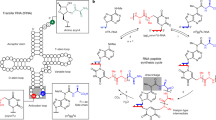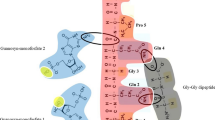Abstract
The RNA world hypothesis refers to a hypothetical era prior to coded peptide synthesis, where RNA was the major structural, genetic, and catalytic agent. Though it is a widely accepted scenario, a number of vexing difficulties remain. In this review we focus on a missing link of the RNA world hypothesis—primitive miniribozymes, in particular ligases, and discuss the role of these molecules in the evolution of RNA size and complexity. We argue that prebiotic conditions associated with freezing, rather than “warm and wet” conditions, could have been of key importance in the early RNA world.




Similar content being viewed by others
References
Bada JL, Bigham C, Miller SL (1994) Impact melting of frozen oceans on the early Earth: implications for the origin of life. Proc Natl Acad Sci USA 91:1248–1250
Bada JL, Lazcano A (2002) Origin of life Some like it hot, but not the first biomolecules. Science 296:1982–1983
Bartel DP, Szostak JW (1993). Isolation of new ribozymes from a large pool of random sequences. Science 261:1411–1418
Berzal-Herranz A, Joseph S, Burke JM (1992). In vitro selection of active hairpin ribozymes by sequential RNA-catalyzed cleavage and ligation reactions. Genes Dev 6:129–134
Berzal-Herranz A, Joseph S, Chowrira BM, Butche SE, Burke JM (1993). Essential nucleotide sequences and secondary structure elements of the hairpin ribozyme. EMBO J 12:2567–2573
Bruce TC, Butler AR (1964) Catalysis in water and ice. II. The reaction of thiolactones with morpholine in frozen systems. J Am Chem Soc 86:4104–4108
Butcher SE, Heckman JE, Burke JM (1995) Reconstitution of hairpin ribozyme activity following separation of functional domains. J Biol Chem 270:29648–29651
Chowrira BM, Berzal-Herranz A, Burke JM (1991) Novel guanosine requirement for catalysis by the hairpin ribozyme. Nature 354:320–322
Chowrira BM, Burke JM (1992) Extensive phosphorothioate substitution yields highly active and nuclease–resistant hairpin ribozymes. Nucleic Acids Res 20:2835–2840
Clifford SM, Parker TJ (2001) The evolution of the martian hydrosphare: implications for the fate of a primordial ocean and the current state of the northern plains. Icarus 154:40–79
Collins RA (2002) The neurospora varkud satellite ribozyme. Biochem Soc Trans 30:1122–1126
Dange V, Van Atta RB, Hecht SM (1990) A Mn2(+)–dependent ribozyme. Science 248:585–588
Ding PZ, Kawamura K, Ferris JP (1996) Oligomerization of uridine phosphorimidazolides on montmorillonite: a model for the prebiotic synthesis of RNA on minerals. Orig Life Evol Biosph 26:151–171
Fedor MJ (2002) The role of metal ions in RNA catalysis. Curr Opin Struct Biol 12:289–295
Fedorova O, Su LJ, Pyle AM (2002) Group II introns: highly specific endonucleases with modular structures and diverse functions. Methods 28:323–335
Feig (2000) The use of manganese as a probe for elucidating the role of magnesium ions in ribozymes. Met Ions Biol Syst 37:157–182
Ferris JP, Hill JAR, Liu R, Orgel LE (1996) Synthesis of long prebiotic oligomers on mineral surfaces. Nature 381:59–61
Gilbert W (1986) The RNA World. Nature 319:618
Grant NH, Alburn HE (1965) Fast reactions of ascorbic acid and hydrogen peroxide in ice, a presumably early environment. Science 150:1589–1590
Grant NH, Alburn HE (1966) Acceleration of enzyme reactions in ice. Nature 212:194
Grant NH, Clark DE, Alburn HE (1961) Imidazole and base-catalyzed hydrolysis of penicillin in frozen systems. J Am Chem Soc 83:4476–4477
Gryaznov SM, Letsinger RL (1993) Chemical ligation of oligonucleotides in the presence and absence of a template. J Am Chem Soc 115:3808–3809
Harris RJ, Elder D (2000) Ribozyme relationships: the hammerhead, hepatitis delta, and hairpin ribozymes have a common origin. J Mol Evol 51:182–184
Holland HD (1984) Chemical evolution of the atmosphere and oceans. Princeton University Press, Princeton, NJ
Jadhav VR, Yarus M (2002) Coenzymes as coribozymes. Biochimie 84:877–888
Johnston WK, Unrau PJ, Lawrence MS, Glasner ME, Bartel DP (2001) RNA-catalyzed RNA polymerization: accurate and general RNA-templated primer extension. Science 292:1319–1325
Joseph S, Burke JM (1993) Optimization of an anti-HIV hairpin ribozyme by in vitro selection. J Biol Chem 268:24515–24518
Joyce G (2002) The antiquity of RNA-based evolution. Nature 418:214–221
Joyce GF (2004) Directed evolution of nucleic acid enzymes. Annu Rev Biochem 73:791–836
Kanavarioti A, Monnard P-A, Deamer DW (2001) Eutectic phases in ice facilitate nonenzymatic nucleic acid synthesis. Astrobiology 1:271–281
Kazakov SA (1996) Nucleic acid binding and catalysis by metal ions. In: Hecht SM (ed) Bioorganic chemistry: Nucleic acids. Oxford University Press, New York, pp 244–287, 467–476
Kazakov S, Altman S (1992). A trinucleotide can promote metal ion-dependent specific cleavage of RNA. Proc Natl Acad Sci USA 89:7939–7943
Kazakov SA, Balatskaya SV, Johnston BH (1998) Freezing-induced self-ligation of the hairpin ribozyme: cationic effects. In: Sarma RH, Sarma MH (eds) Structure, motion, interaction and expression of biological macromolecules. Adenine Press, Albany, New York, pp 155–161
Kiovsky TE, Pincock RE (1966) The mutarotation of glucose in frozen aqueous solutions. J Am Chem Soc 88:4704–4710
Kirsebom LA (2002) RNase P RNA-mediated catalysis. Biochem Soc Trans 30:1153–1158
Kumar R, Yarus M (2001) RNA-catalyzed amino acid activation. Biochemistry 40:6998–7004
Kuntz ID, Brassfield TS, Law GD, Purcell GV (1969) Hydration of macromolecules. Science 163:1329–1331
Lacey JC Jr, Staves MP, Thomas RD (1990) Ribonucleic acids may be catalysts for the preferential synthesis of L-amino acid peptides: a minireview. J Mol Evol 31:244–248
Landweber L (1999) Experimental RNA Evolution. TREE 14:353–358
Landweber LF, Pokrovskaya ID (1999) Emergence of a dual-catalytic RNA with metal-specific cleavage and ligase activities: the spandrels of RNA evolution. Proc Natl Acad Sci USA 96:173–178
Landweber LF, Simon PJ, Wagner TA (1998) Ribozyme design and early evolution. BioScience 48:94–103
Larralde R, Robertson MP, Miller SL (1995) Rates of decomposition of ribose and other sugars: implications for chemical evolution. Proc Natl Acad Sci USA 92:8158–8160
Lazcano A, Miller SL (1996) The origin and early evolution of life: prebiotic chemistry, the pre-RNA world, and time. Cell 85:793–798
Lee DH, Granja JR, Martinez JA, Severin K, Ghadiri MR (1996) A self-replicating peptide. Nature 382(6591):525–528
Leman L, Orgel L, Ghadiri MR (2004) Carbonyl sulfide-mediated prebiotic formation of peptides. Science 306(5694):283–286
Levy M, Miller SL (1998) The stability of the RNA bases: implications for the origin of life. Proc Natl Acad Sci USA 95:7933–7938
Levy M, Miller SL, Oró J (1999) Production of guanine from NH(4)CN polymerizations. J Mol Evol 49:165–168
Lilley DM (2003) The origins of RNA catalysis in ribozymes. Trends Biochem Sci 28:495–501
Liu R, Orgel LE (1997) Efficient oligomerization of negatively-charged beta-amino acids at −20 degrees. CJ Am Chem Soc 119(20):4791–4792
Lundbäck T, Härd T (1996) Sequence-specific DNA-binding dominated by dehydration. Proc Natl Acad Sci USA 93:4754–4759
McGinness KE, Joyce GF (2003) In search of an RNA replicase ribozyme. Chem Biol 10:5–14
Meierhenrich UJ, Munoz Caro GM, Bredehoft JH, Jessberger EK, Thiemann WH (2004) Identification of diamino acids in the Murchison meteorite. Proc Natl Acad Sci USA 101(25):9182–9186
Miller SL (1953) A production of amino acids under possible primitive earth conditions. Science 117:528–529
Miyakawa S, Cleaves HJ, Miller SL (2002) The cold origin of life: B. Implications based on pyrimidines and purines produced from frozen ammonium cyanide solutions. Orig Life Evol Biosph 32:209–218
Monnard P-A, Kanavarioti A, Deamer D (2003) Eutectic phase polymerization of activated ribonucleotide mixtures yields quasi-equimolar incorporation of purine and pyrimidine nucleobases. J Am Chem Soc 125:13734–13740
Monnard P-A (2005) Catalysis in abiotic structured media: an approach to selective synthesis of biopolymers. Cell Mol Life Sci 62:520–534
Murray JB, Seyhan AA, Walter NG, Burke JM, Scott WG (1998) The hammerhead, hairpin and VS ribozymes are catalytically proficient in monovalent cations alone. Chem Biol 5:587–595
Nesbitt SM, Erlacher HA, Fedor MJ (1999) The internal equilibrium of the hairpin ribozyme: temperature, ion and pH effects. J Mol Biol 286:1009–1024
Orgel LE, Lohrmann R (1974) Prebiotic chemistry and nucleic acid replication. Acc Chem Res 7:368–377
Pace NR (1991) Origin of life—Facing up to the physical setting. Cell 65:531–533
Prusoff WH (1963) Low-temperature reversal of the ultraviolet photochemical reaction product of 2′-deoxyuridive. Biochim Biophys Acta 68:302–310
Psenner R, Sattler B (1998) Life at the freezing point. Science 280:2073–2074
Pyle AM (1993) Ribozymes: a distinct class of metalloenzymes. Science 261:709–714
Pyle AM (2002) Metal ions in the structure and function of RNA. J Biol Inorg Chem 7:679–690
Rau DC, Le B, Parsegian VA (1984) Measurement of the repulsive force between polyelectrolyte molecules in ionic solution: hydration forces between parallel DNA double helices. Proc Natl Acad Sci USA 81:2621–2625
Renz M, Lohrmann R, Orgel LE (1971) Catalysts for the polymerization of adenosine cyclic 2′, 3′–phosphate on a poly(U) template. Biochim Biophys Acta 240:463–471
Ricardo A, Carrigan MA, Olcott AN, Benner SA (2004) Borate minerals stabilize ribose. Science 9:196
Sanchez R, Ferris J, Orgel LE (1966) Condition for purine synthesis: Did prebiotic synthesis occur at low temperatures? Science 153:72–73
Schmidt F (1999) Ribozymes—Why so many, why so few? Mol Cells 9:459–463
Schuster M, Aaviksaar A, Haga M, Ullmann U, Jakubke HD (1991) Protease-catalyzed peptide synthesis in frozen aqueous systems: the “freeze-concentration model.” Biomed Biochim Acta 50:84–89
Siwkowski A, Humphrey M, De-Young MB, Hampel A (1998) Screening for important base identities in the hairpin ribozyme by in vitro selection for cleavage. Biotechniques 24:278–284
Squyres SW, Grotzinger JP, Arvidson RE, Bell JF III, Calvin W, Christensen PR, Clark BC, Crisp JA, Farrand WH, Herkenhoff KE, Johnson JR, Klingelhofer G, Knoll AH, McLennan SM, McSween HY Jr, Morris RV, Rice JW Jr, Rieder R, Soderblom LA (2004) In situ evidence for an ancient aqueous environment at Meridiani Planum, Mars. Science 306:1709–1714
Szathmary E (1999) The origin of the genetic code: amino acids as cofactors in an RNA worldTrends Genet 15:223–229
Tamura K, Alexander RW (2004) Peptide synthesis through evolution. Cell Mol Life Sci 61:1317–1330
Tõugu V, Talts P, Meos H, Haga M, Aaviksaar A (1995) Aminolysis of acyl-chymotrypsins by amino acids. Kinetic appearance of concentration effect in peptide yield enhancement by freezing. Biochim Biophys Acta 1247:272–276
Usher DA (1977) Early chemical evolution of nucleic acids: a theoretical model. Science 196:311–313
Van Atta RB, Hecht SM (1994) A ribozyme model: site-specific cleavage of an RNA substrate by Mn2+. Adv Inorg Biochem 9:1–40
Vlassov A, Khvorova A, Yarus M (2001) Binding and disruption of phospholipid bilayers by supramolecular RNA complexes. Proc Natl Acad Sci USA 98:7706–7711
Vlassov AV, Johnston BH, Landweber LF, Kazakov SA (2004) Ligation activity of fragmented ribozymes in frozen solution: implications for the RNA world. Nucleic Acids Res 32:2966–2974
Walter NG, Burke JM (1998) The hairpin ribozyme: structure, assembly and catalysis. Curr Opin Chem Biol 2:24–30
Walter NG, Engelke DR (2002) Ribozymes: catalytic RNAs that cut things, make things, and do odd and useful jobs. Biologist 49:199–203
Weber AL, Miller SL (1981) Reasons for the occurrence of the twenty coded protein amino acids. J Mol Evol 17:273–284
Westhof E (2002) Group I introns and RNA folding. Biochem Soc Trans 30:1149–1152
Yarus M (1999) Boundaries for an RNA world. Curr Opin Chem Biol 3:260–267
Yarus M, Caporase JG, Knight R (2005) ORIGINS OF THE GENETIC CODE: The Escaped Triplet Theory. Annu Rev Biochem 74:179–198
Zhang B, Cech TR (1997) Peptide bond formation by in vitro selected ribozymes. Nature 390:96–100
Author information
Authors and Affiliations
Corresponding author
Additional information
[Reviewing Editor: Dr. Niles Lehman]
Rights and permissions
About this article
Cite this article
Vlassov, A.V., Kazakov, S.A., Johnston, B.H. et al. The RNA World on Ice: A New Scenario for the Emergence of RNA Information. J Mol Evol 61, 264–273 (2005). https://doi.org/10.1007/s00239-004-0362-7
Received:
Accepted:
Published:
Issue Date:
DOI: https://doi.org/10.1007/s00239-004-0362-7




